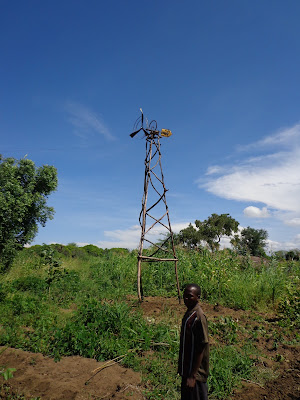On the return journey of a recent field trip to irrigation sites in the Malawian lakeshore district Salima, we practically stumbled upon a local windmill. Tucked behind an acacia grove, so invisible to the many cyclists and motorists passing by, a recent high school graduate had been busy making his dream machine: a windmill generator/water pump.
He had heard we passed by on our way to the field and waited by the roadside four hours until we returned. Before we could get back on the tarmac and drive away oblivious to his invention, he flagged us down and directed us to his home and the 30' tower made from eucalyptus globulus (blue gum) poles.
While the unit did not generate electricity yet, he was preparing to mount a bicycle dynamo to the wheel. We gave him some pointers to help him understand what was happening. He could really understand the kind of power he was looking for and how his design might not work.
Before leaving we gave the best encouragement we could, don't give up, etc., (knowing that this kid probably didn't need any more encouragement than his own ambition). In the car again, we discussed what we could do to help. We came up with a few designs we could build in the workshop and bring back to show him next month. Of course we hope he will also have some improvements by then.
These gems are found throughout the world if only we could find them all!
Saturday, March 2, 2013
Composting round 2
Even as a club, making a heap of compost and manure like this is tiring, especially during nthawi ya njala (that is, time of hunger: the colloquial name for the months of January-March). Caloric intake is down, but so are traditional work loads; cultivation is finished, harvesting is pending, and there's little to do on the farms, traditionally. But modern farming, sustainable farming, is a year round endeavor.
The farmers get tired but just when they seem to be giving up, we start talking about what this pile of animal droppings is worth in fertilizer equivalent. First we ask the farmer's what they would charge for this work if they were hired piece workers on someone's farm. The job usually ticks in at about K4,000-K5,000 kwacha. Then we explain that this heap of manure will yield roughly 1 metric ton of compost, enough to supply the nutrients required to grow one quarter acre of corn. Corn, as we all know, requires 200kg of inorganic fertilizer per acre, or 50kg per quarter acre, which costs about K15,000. Thus, the fertilizer equivalent of the compost costs three times more than they would charge for the labour to prepare the compost.
Of course, if you do it wrong, this compost could have a low nutrient content or take ages to decompose into a usable substance. No one said it didn't take some skill. But it is worth the effort, and the farmers tend to pick up their feet a bit higher once they can quantify the fruits of their labour.
So far we have seen some very good work from farmers and we look forward to seeing how far they take the skills when we are not around to watch each step.
Subscribe to:
Posts (Atom)

.JPG)






